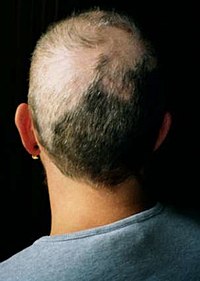
Photo from wikipedia
BACKGROUND Patients with obsessive-compulsive disorder (OCD) display disrupted performance and abnormal lateral orbitofrontal cortex (LOFC) activity during reversal learning tasks. However, it is unknown whether compulsions and reversal learning deficits… Click to show full abstract
BACKGROUND Patients with obsessive-compulsive disorder (OCD) display disrupted performance and abnormal lateral orbitofrontal cortex (LOFC) activity during reversal learning tasks. However, it is unknown whether compulsions and reversal learning deficits share a common neural substrate. To answer this question, we measured neural activity with in vivo calcium imaging in LOFC during compulsive grooming and reversal learning before and after fluoxetine treatment. METHODS Sapap3 knockout (KO) mice were used as a model for OCD-relevant behaviors. Sapap3 KOs and control littermates were injected with a virus encoding GCaMP6f and implanted with gradient-index lenses to visualize LOFC activity using miniature microscopes. Grooming, reversal learning, and neural activity were measured pre- and post-fluoxetine treatment (18 mg/kg, 4 weeks). RESULTS Baseline compulsive grooming and reversal learning impairments in KOs improved after fluoxetine treatment. In addition, KOs displayed distinct patterns of abnormal LOFC activity during grooming and reversal learning, both of which normalized after fluoxetine. Finally, reversal learning-associated neurons were distributed randomly among grooming-associated neurons (i.e., overlap is what would be expected by chance). CONCLUSIONS In OCD, LOFC is disrupted during both compulsive behaviors and reversal learning, but whether these behaviors share common neural underpinnings is unknown. We found that LOFC plays distinct roles in compulsive grooming and impaired reversal learning and their improvement with fluoxetine. These findings suggest that LOFC plays separate roles in pathophysiology and treatment of different perseverative behaviors in OCD.
Journal Title: Biological psychiatry
Year Published: 2021
Link to full text (if available)
Share on Social Media: Sign Up to like & get
recommendations!